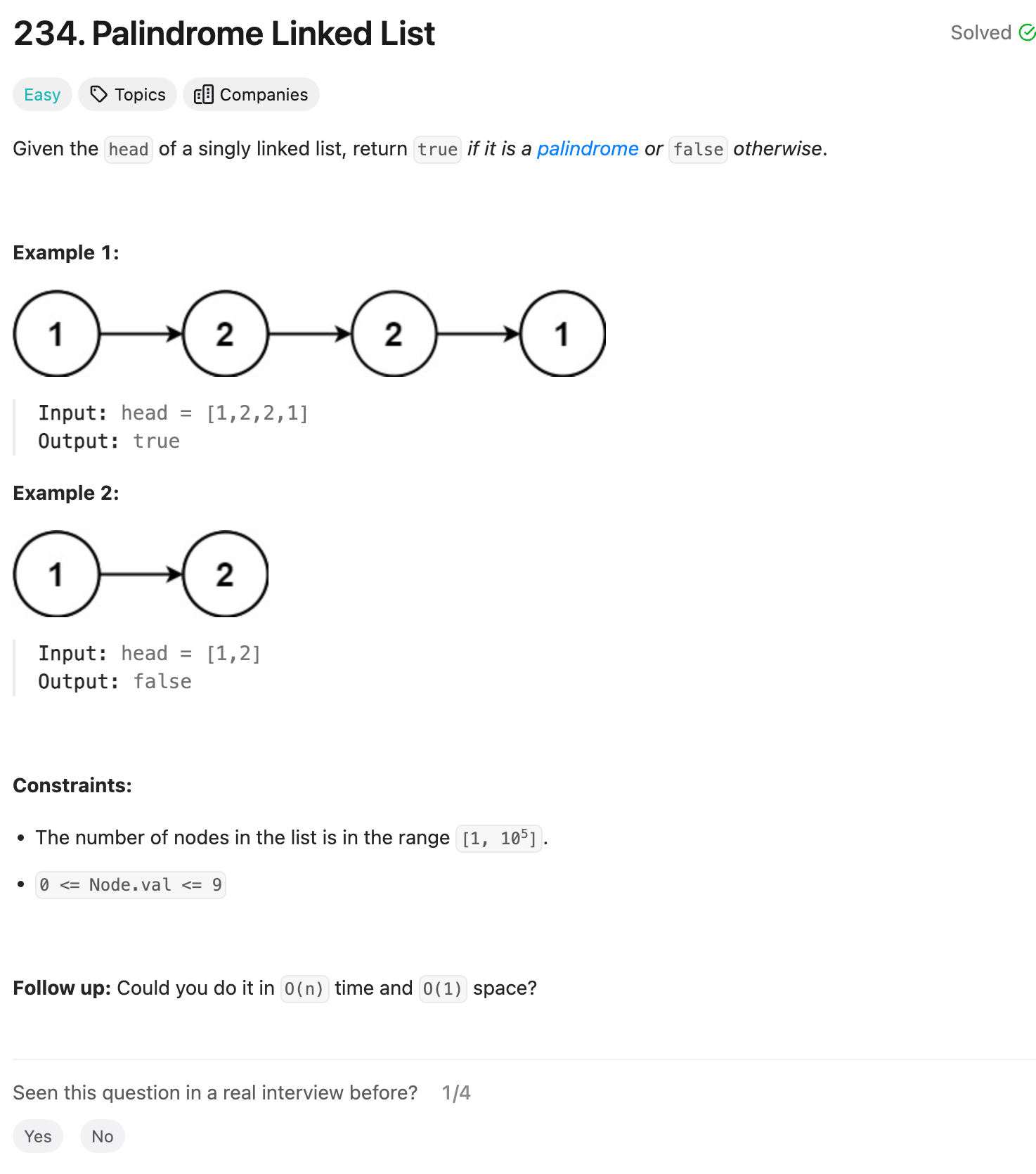Problem of The Day: Palindrome Linked List
Problem Statement

Intuition
My initial thought is to use the two-pointer approach to find the middle of the linked list. Then, reverse the second half of the list and compare it with the first half to check if it forms a palindrome.
Approach
I start by initializing two pointers, p and q, both pointing to the head of the linked list. Then, I move p one step at a time and q two steps at a time until q reaches the end of the list. This way, when q reaches the end, p will be at the middle (or slightly left of the middle) of the list.
After finding the middle, I reverse the second half of the list. I use another pointer, prev, to keep track of the reversed part. Once the reversal is done, I compare the values of nodes from the first half (from the original head) with the reversed second half.
If the values match for all corresponding nodes, the linked list is a palindrome. If any pair of corresponding nodes has different values, I return False.
Complexity
-
Time complexity: Finding the middle and reversing the second half both take O(n/2) time, where n is the number of nodes in the linked list. The final comparison also takes O(n/2) time. Therefore, the overall time complexity is O(n).
-
Space complexity: I use a constant amount of extra space for pointers and variables, so the space complexity is O(1).
Code
# Definition for singly-linked list.
# class ListNode:
# def __init__(self, val=0, next=None):
# self.val = val
# self.next = next
class Solution:
def isPalindrome(self, head: Optional[ListNode]) -> bool:
prev = None
p, q = head, head
while q and q.next:
prev = p
p = p.next
q = q.next.next
if prev:
prev.next = None
q = head
prev = None
while p:
next_node = p.next
p.next = prev
prev = p
p = next_node
p = prev
while p and q:
if p.val != q.val:
return False
p = p.next
q = q.next
return True
Editorial Solution
Brute Force
def isPalindrome(self, head: ListNode) -> bool:
vals = []
current_node = head
while current_node is not None:
vals.append(current_node.val)
current_node = current_node.next
return vals == vals[::-1]
- Time complexity: O(n)
- Space complexity: O(n)
Approach 2: Recursive (Advanced)
def isPalindrome(self, head: ListNode) -> bool:
self.front_pointer = head
def recursively_check(current_node=head):
if current_node is not None:
if not recursively_check(current_node.next):
return False
if self.front_pointer.val != current_node.val:
return False
self.front_pointer = self.front_pointer.next
return True
return recursively_check()
- Time complexity: O(n)
- Space complexity: O(n)
Approach 3: Reverse Second Half In-place
class Solution:
def isPalindrome(self, head: ListNode) -> bool:
if head is None:
return True
# Find the end of first half and reverse second half.
first_half_end = self.end_of_first_half(head)
second_half_start = self.reverse_list(first_half_end.next)
# Check whether or not there's a palindrome.
result = True
first_position = head
second_position = second_half_start
while result and second_position is not None:
if first_position.val != second_position.val:
result = False
first_position = first_position.next
second_position = second_position.next
# Restore the list and return the result.
first_half_end.next = self.reverse_list(second_half_start)
return result
def end_of_first_half(self, head):
fast = head
slow = head
while fast.next is not None and fast.next.next is not None:
fast = fast.next.next
slow = slow.next
return slow
def reverse_list(self, head):
previous = None
current = head
while current is not None:
next_node = current.next
current.next = previous
previous = current
current = next_node
return previous
- Time complexity: O(n)
- Space complexity: O(1)